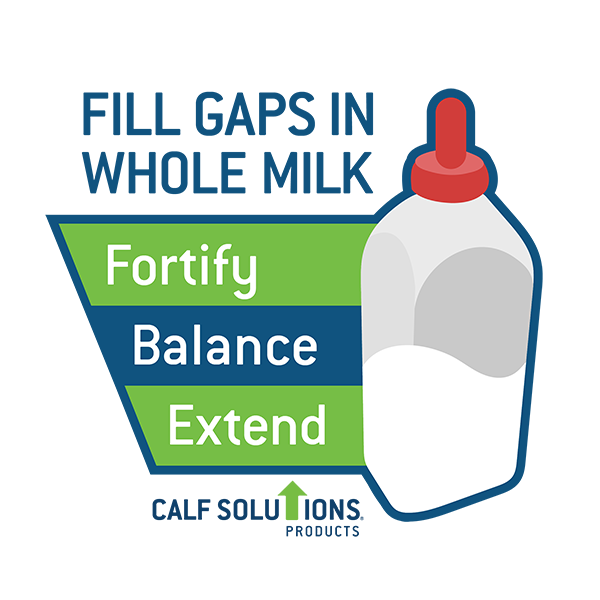Give whole milk a boost to give calves the balanced nutrition they need. Milk: It’s “nature’s most perfect food,” or at least that’s what we’ve been told as long as humans have been feeding domesticated dairy calves.
Whole milk is an excellent foundation to a liquid nutrition feeding program, but it often lacks the necessary vitamins, minerals and optimal fat-to-protein ratio that calves need to feel and perform their best. “Think about whole milk diets in the same way you think about lactating rations,” says Skip Olson, technical services veterinarian for Milk Products. “You and your nutritionist work together to provide consistent, power-packed nutrition to your lactating herd in your total mixed ration (TMR). Make the same commitment to fortify and balance whole milk to optimize calf health and growth.”

Here are five ways to step up your whole milk feeding program:
1. Fortify to make up for what is missing
Just as grocery store milk is fortified with Vitamin D for humans, calf milk, too, should be enhanced with fortification. According to National Research Council (NRC) guidelines for pre-weaned dairy calves, whole milk is deficient in most vitamins and minerals.
“Fortifying the liquid ration with a vitamin and trace mineral pack can help ensure every calf receives essential nutrients at a fixed dose per day,” says Olson. “Milk fortifiers also can deliver a host of other beneficial agents to calves through their milk ration, including coccidiostats, ionophores, larvacides, yeast supplements and essential oils.”
2. Balance for consistent nutrition
Standard whole milk has about 12.5 percent solids. Waste milk, by its very nature, is much more variable – ranging from 5 to 14 percent solids on any given day. That’s not the kind of TMR-like consistency you want for your calves.
“A powdered balancer can make up for solids shortfalls and adjust the protein-to-fat ratio in calf diets,” says Olson.
A Brix refractometer is a simple and affordable tool that can be used on-farm to evaluate solids content in waste milk. To best maintain consistency, milk should be tested every time it changes so you keep tabs on its contents. “Brix plus two” is the standard indicator for solids level. For example, if the Brix reading is 8, that batch of milk contains approximately 10 percent solids.
“Balancers are high in protein and can be used to re-elevate the protein level after water is added to drop, or dilute, the fat content in waste milk, much like high-performance milk replacers,” says Olson. “A good guideline is to strive for a protein-to-fat rate of 1.4; for example, 26:20 or 28:20.”
3. Extend to help with milk shortages
Most dairies have enough waste milk to provide 30 to 60 percent of the necessary supply to feed their pre-weaned calves.
“Extender products – which are similar to traditional, 20:20 milk replacer – can be mixed with water and waste milk to stretch the supply to meet your daily feeding needs,” says Olson. “The correct amount of water is usually added to the milk powder, so it matches the solids level of the whole milk or to meet another solids goal of the resulting mixture.”
Alternatively, some dairies use milk replacer to make up for this shortfall by feeding in age groups. For example, they may feed milk replacer to newborn calves up to 3 weeks of age and waste milk to older calves through weaning.
4. Preserve the salable milk supply
Making up for waste milk shortfalls with salable, bulk tank milk may be easy, but it may not be economical.
“If you are in the business of selling milk, you should avoid disrupting that revenue stream,” says Olson. “Even in periods of low milk supplies, it is almost always better – in terms of economics and consistency – to balance, extend and/or fortify waste milk, versus feeding salable, bulk-tank milk.”
5. Provide other essential feedstuffs
Whole milk should not be the only feedstuff offered to dairy calves after the first few days of life.
“Providing free-choice water and starter grain – and training calves to consume them – promotes physical rumen growth and development of critical rumen microbes. Water also aids in the digestion of high-solids liquid diets,” says Olson.
Whole milk is and will continue to be the foundation of a great calf nutrition program, but as calf performance goals continue to increase, so must the level of nutrition. To keep up with calf growth demands and shorter weaning times, think of whole milk as a part of a strong liquid ration, not as the sole nutrition source.
Learn more at wholemilktruth.com.





